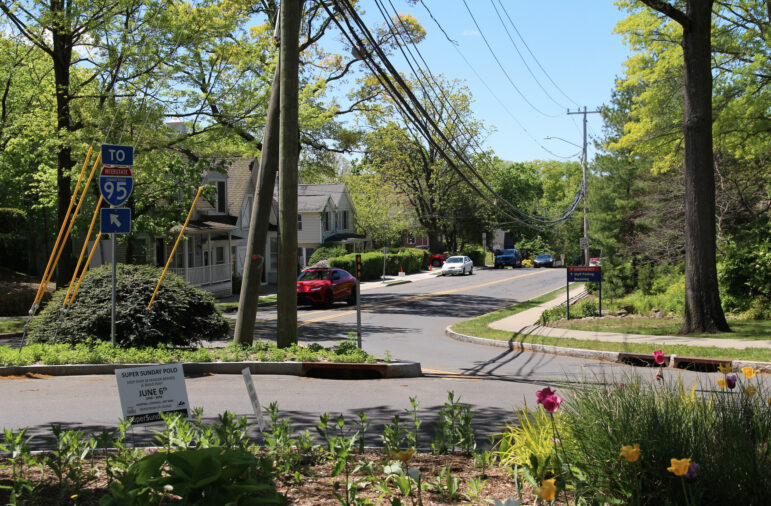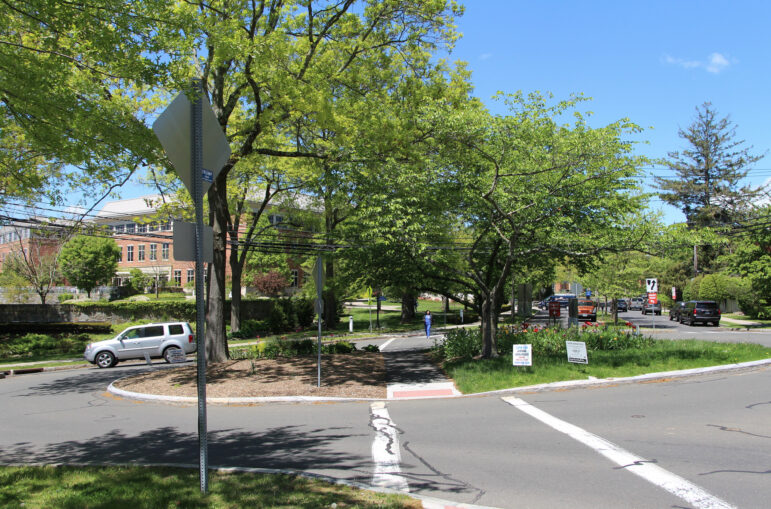It felt a little like déja vu, but on Thursday afternoon the Greenwich P&Z commission voted to deny Greenwich Hospital’s proposed Smilow Cancer Center.
In the first round of meetings, neighbors railed against the proposal, citing concerns about noise, delivery trucks, generator testing and even homeless people sleeping in a hospital courtyard.
In 2021 the proposal was denied 5-0 by the Planning & Zoning commission and the hospital initiated litigation.
This Thursday, the vote was 4 to 1 on a motion to approve, with Margarita Alban, Dennis Yeskey, Peter Lowe, and Peter Levy voting against, and Nick Macri voting in favor.

The item was on the agenda at the previous P&Z meeting and the applicant’s attorney and doctors all spoke at length.
The commission closed the item, which meant they would take no further input from the applicant or public.
The application had two parts: a request to rezone from RMF (residential multi-family) to H2 Hospital zone, and a site plan.
Once the rezone was declined, the site plan was moot, but required a vote nonetheless. That also failed.
Motion to Approve
Initially Mr. Macri presented a motion to approve the rezone of 8 parcels equal to 94,869 sq ft of property along Lake Ave and Lafayette.
His motion referred to a demonstrated gap in the oncological needs of the community that could be fulfilled with the facility, and noted the applicant had said 40% of Greenwich residents seek cancer care services in places around New York City that are not provided locally, and that the rate of cancer was anticipated to increase.



Macri also said the proposal was in keeping with the town’s 2019 POCD and that the comprehensive care center was a “clinic” and therefore an H2 use.
Therefore, he said it would be appropriate to rezone the properties for this use to provide the best quality of services per the POCD.
His motion noted the existing Bendheim Cancer Center had been determined by a previous commission to be an H2 use.
The proposed location would allow for oncologists to see their patients who are admitted to the hospital before and after visiting the “clinic,” and eliminate the need for patients and caregivers to have to travel by car to other locations.
Destroying a Residential Neighborhood
Commissioner Peter Lowe spoke against the motion, saying a residential neighborhood should not be “destroyed.”
“The applicant’s selection of this particular site seems to be in direct conflict with our town’s POCD primary guiding principle,” Mr. Lowe said.
“I struggle with the need to sacrifice a residential neighborhood to offer enhanced cancer care given the availability of a variety of commercial sites both within Greenwich and nearby, many of which are already home to a host of specialized healthcare services and centers,” Mr. Lowe continued.
He added that the regulations were clear about the intent and purpose of hospital zones including meeting the major medical needs of Greenwich.
“I remain skeptical about the fundamental need for a comprehensive cancer center here in town,” he added.
Mr. Lowe noted that while roughly two-thirds of states in the US have no more than a single comprehensive cancer center, Greenwich had at least four such facilities within an hour’s drive, as well as several satellites of renowned major cancer hospitals less than 20 minutes away.
Mr. Yeskey agreed with Mr. Lowe and said he was prepared to vote.
Ms Alban said, “This is a health center. I think it’s a lot like the dialysis center we recently approved.”
She said she had been pondering why the applicant wouldn’t put the health center in a commercial district.
“It is Use Group 4, and they are allowed in the LB, CGB, GB and GBO zones,” she said. “This is a good fit to have in a more commercial zone as well.”
Alban said she struggled about the proposal’s appropriateness and consistency with the POCD.
“This has been so, so hard to do,” Alban said. “We’ve lived the cancer situation as a commission. We’ve experienced it, and this is a very hard decision, but I still lean toward the protection of neighborhoods – that is in our POCD.”
Commissioner Peter Levy agreed with Lowe, Yeskey and Alban that the center didn’t need to be at this location, and could be situated in a commercial zone.
Mr. Macri disagreed.
“They’ve gone out of their way to see what the POCD says in terms of providing things back to the town: Thriving commercial centers, best quality infrastructure, cultural institutions and health services, and more green space, which is guiding principle #4, educational facilities – they’re teaching.”
As far as “preserving community character,” Macri said the neighborhood already included both small and tall residential buildings.
Ms Alban said it was a question of how to prioritize conflicting POCD guiding principles.
“First and foremost is community character and sense of place. Housing opportunities is the second most important. This is an RMF neighborhood adjacent to a historic district,” Alban said. “We are guided by the prioritizations in our POCD.”
Still Mr. Macri disagreed. “This is one of the true mixed neighborhoods: single family residences, offices, large multi-family residences, the hospital itself. Starting from the Post Road and that commercial area to the First Presbyterian Church, Fairfield House, Bendheim Center and 49 Lake (medical office building). There is a real mix in this neighborhood.”
“On paper it fits,” Mr. Levy said. But, he added, “There’s a lot of unknowns, and there are other options for such a facility. Does it need to be here? That’s the question.”
After the four commissioners voted no on Macri’s motion, it failed 4-1.
Motion to Deny
Next, Ms Alban proposed a lengthy alternate motion, which was to deny.
She noted the intent and purpose of hospital zones was to meet Greenwich’s major medical needs and ensure compatibility with the town’s POCD.
She said there are currently 7 comprehensive cancer centers recognized by the National Cancer Institute within one hour of Greenwich.
In addition, the Bennett Cancer Center, located six miles from Greenwich provides care through its partnership with Dana-Farber Brigham, a recognized comprehensive cancer center.
The White Plains Hospital, through its partnership with Montefiore Einstein Comprehensive Cancer Center, provides care 10 miles from Greenwich.
Memorial Sloan Kettering Cancer Center has a satellite facility in Harrison, NY, eight miles from Greenwich. MSK also has a collaboration with Norwalk Hospital 14 miles from Greenwich, which is known as MSK Physicians at Norwalk Hospital.
“The applicant has acknowledged, along with the facility already in Greenwich, there are 14 more Smilow Cancer Centers in Connecticut, and some of these facilities are not co-located with hospitals,” Alban said as part of her motion.
She acknowledged the proposed Smilow Greenwich Cancer Center would offer clinical trials and innovative treatment opportunities not currently available in Greenwich.
However, she said, the applicant anticipated 60% of patients for the cancer center in the proposed H2 zone were expected to reside outside Greenwich, and that in Greenwich, as an aging community, cancer rates would potentially rise.
“However, the public record for this application also includes state public health department statistics with declining cancer rates in both New York and Connecticut,” Alban said. “Greenwich residents do not always age in place and may relocate to other geographic areas.”
“Despite ongoing requests …the commission finds the applicant has not provided compelling data to support how specific current and future needs of the Town of Greenwich are not being met by existing local area cancer care facilities,” Alban added.
Alban said the POCD’s guiding principles first priorities start with preserving community character and sense of place, developing housing opportunities for the future, supporting top quality educational facilities, sustaining and improving natural environment and landscapes, maintaining economic vitality and thriving commercial centers, providing the best quality infrastructure, municipal facilities, cultural institutions and health services.
“The proposed rezoning removes residential and mixed use buildings from eight parcels of land with a proposed conversion to institutional use. The proposed rezoning is in close proximity to a national register historic district. The proposed facility would provide 120 parking spaces, where 169 parking spaces are needed.”
Alban noted that parking was expected to be available at other hospital garages, but patients would need to be guided by illuminated signage at the lots.
The applicant’s consultant, Tighe & Bond, testified that hospital visitors from other municipalities can struggle to locate the existing facility and would benefit from significant wayfinding assistance.
“This signage would be institutional in character and possibly ubiquitous,” Alban said.
She said it was a cause for concern that this would transform the existing streetscape of the neighborhood into that of an urban medical center.
Alban’s motion said that as for for guiding POCD principle #2, as stated in the 2019 POCD, residential neighborhoods are the primary building block of the town, comprising the majority of the land use and acting as the main setting for the day-to-day life of most residents. In reducing the number of parcels zoned for residential use, this proposal is counter to guiding principle 2.
As for guiding principle #6, Alban said the applicant had stated the intent was to provide best quality cancer care services, but had not demonstrated how the proposed facility met the specific unmet needs of Greenwich, or why the facility could not be located elsewhere in Greenwich or another community.
Finally, she said the fundamental need for the change had not been fully established despite an ongoing line of inquiry from the commission.
“The commission therefore finds that the proposed rezoning from RMF to H2 meets neither the key intents and purposes of the H2 zone, nor the highest priorities of the 2019 Greenwich POCD, and is hereby denied.”
Mr. Yeskey agreed with the motion.
“This is just a major conflict with the two most important objectives of the POCD,” he said.
Mr. Macri disagreed, repeating that the proposal was within a mixed use neighborhood and added greenspace by including a public park.
He talked about “highest and best use” and noted the neighborhood was already a very diversified mixed area of buildings of different scales and different uses.
“Yes it could be in a another place, but the property is owned by the applicant,” he said. “They want to make the best use of their property. It’s right next to an H2 and H1 zone.”
Alban said she loved the applicant’s site plan, and it was okay that 60% of users would come from outside Greenwich. But, she said, “losing an established neighborhood in exchange — I honestly think a cancer center of this magnitude would be an asset for Greenwich. A lot of the issue is around the rezone.”
“I know I’m not going to sway you,” Alban said to Macri. “You said ‘highest and best use.’ It is not ours to do highest and best use for the applicant. Ours is to do highest and best use for the town.”
“Anything we can do to sway you, Nick?” Alban asked.
“No,” Macri responded.
Peter Levy had the final comment. “Just the access in a commercial district is preferable as well because people coming to a residential community and going through the arteries of town that are not commercial is not ideal.”
The vote to deny was 4 in favor (Alban, Yeskey, Levy, Lowe) and 1 opposed (Macri).
See also:
After P&Z Denial, Greenwich Hospital Returns with Updated Smilow Cancer Center Proposal March 27, 2022
Greenwich P&Z Commission Denies 54,865 Sq Ft Smilow Cancer Center August 2021
Residents Lash Out at Greenwich Hospital during Zoom Forum for Proposed Smilow Cancer Center
July 24, 2021
Residents and P&Z Push Back on Smilow Cancer Center: building, parking, traffic, neighborhood
July 23, 2021